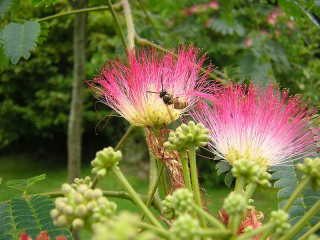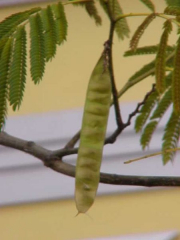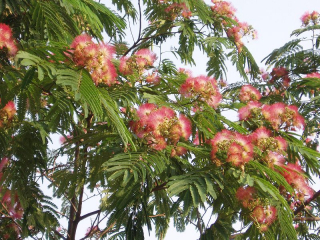Albizia julibrissin, known variously as the pink siris, the Persian silk tree, the sleeping tree, or (incorrectly) as a mimosa, is a common ornamental garden and street tree. It has a graceful, elegant shape reminiscent of a jacaranda or acacia, with smooth light brown or grey bark and feathery, bright green leaves. The tree grows up to 12m tall, with an open, umbrella shaped canopy, providing dappled shade and allowing enough light through for other plants to grow underneath the tree. At night, and during periods of rain, the leaves close up as if the tree is sleeping, leading to the common name ‘sleeping tree’. It is also deciduous, losing all its leaves over the winter even in areas with mild winter temperatures.
The flowers resemble pom-poms of silk threads, which appears to be the origin of the name ‘Persian silk tree’. They have no petals, and consist mainly of a dense cluster of stamens. They are fragrant, light to dark pink, and arranged in loosely branched, pyramidal flower clusters at the ends of the branches. The flowers are attractive to bees, and to nectar feeding birds including hummingbirds. Fruits are flat seed pods 12 – 18cm long, containing light brown, oval-shaped seeds. These pods are gray-brown when mature and remain on the tree into winter. The seeds and foliage may be used as a food for livestock and wildlife, although care should be taken as the seeds may contain some levels of toxic amino acids and saponins.
Silk tree seeds have impermeable seed coats that allow them to remain dormant for many years. One study showed that 90% of the seeds were viable after 5 years. Treatment with boiling water or sulfuric acid decreases the germination time, but germination rates are high even without treatment. Seedlings transplant readily, and are very adaptable.
Pink siris is found in disturbed areas, including coastal and urban areas. It functions as a pioneer plant; it is drought tolerant, wind tolerant, and will tolerate both salinity and alkalinity in the soil as well as salt spray in coastal areas. It will also resprout strongly when damaged. Pink siris is frost tolerant, but prefers areas of high summer heat. It has been used for land reclamation because of its ability to establish itself on marginal sites. In spite of this, pink siris trees often die at a relatively early age due to fungal diseases (specifically mimosa vascular wilt, a form of fusarium wilt), to which they are susceptible.
A tea made out of the flowers of this tree is used in traditional Chinese and Korean medicine to ward off confusion and dark feelings; a clinical study by Korean physicians found that the methylene chloride fraction of Albizzia julibrissin extract produced an antidepressant-like effect in mice. Further research is needed to verify this effect.
What pink siris trees need:
- Water – about 1000mm rain or irrigation annually.
- Sunlight – In its native range, A. julibrissin prefers open sunny ravines.
- Soil – Prefers sandy loam-medium loam soil and can withstand high soil pH and salinity.
What pink siris trees have to offer:
- Fodder for livestock – the foliage meets the nutritional requirements of cattle and domestic goats, with similar digestibility to alfalfa. In a domestic sheep feeding trial, mimosa digestibility was 61%, and there were no signs of toxicity. The tree tolerates 2 complete defoliations during the grazing season.
- Nectar for honeybees, other insects, and birds.
- Erosion and salinity control – Pink siris is cultivated on terrace edges in the Himalayas to prevent soil erosion. It will grow in marginal areas, and tolerates salinity and poor soils.
- Reclamation and soil improvement – Withstands drought and can adapt well in arid conditions. It is a nitrogen fixing legume, and provides plentiful leaf litter to improve soils.
- Shade and shelter in the garden.
- More pink siris trees, which grow easily and quickly from seed.
Images sourced from Wikimedia Commons:
File:Albiza_julibrissin1.jpg
File:Albizia_julibrissin_boubri.jpg
File:AlbizziaJulibrissin3.jpg



Also note – Pink Siris are unbelievably tough. Viciously attacked by mealybugs, growing tips nipped off by rabbits or wallabies, mostly neglected over a not very wet winter and a large part of a rather dry summer – and they’re thriving. new baby green leaves coming out on _all_ the seedlings we planted. These trees are win.